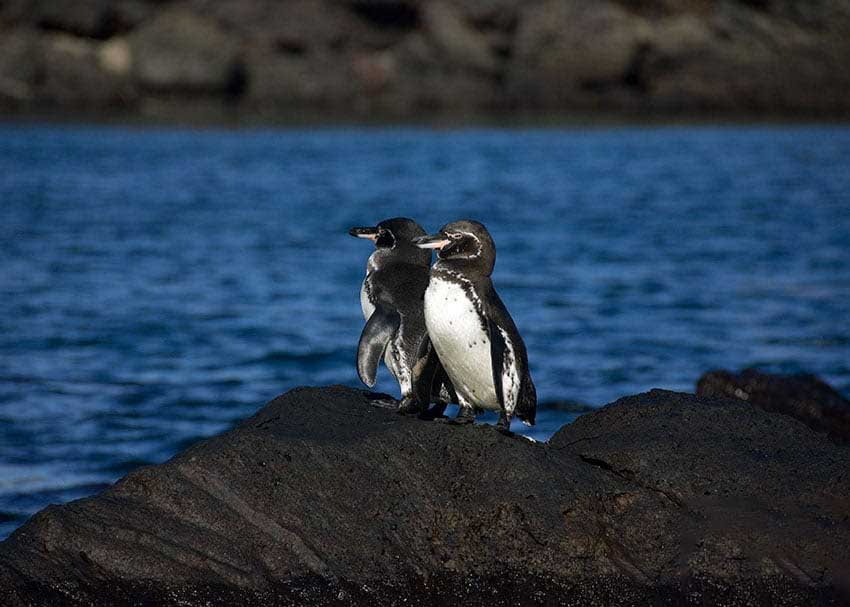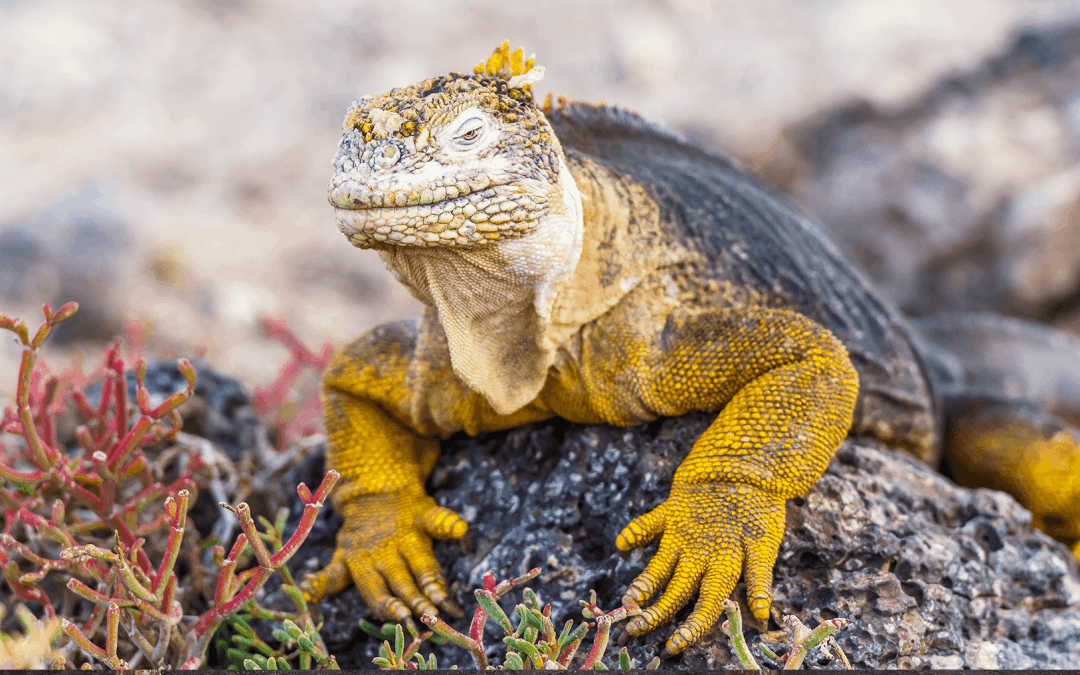Curious about the warm-water Galapagos penguins? Here are 12 Galapagos penguins facts.

12 Galapagos Penguins Facts
In this post, you’ll learn 12 interesting facts about Galapagos penguins. Let’s get started!
1) Galapagos Penguins Live Further North Than Any Other Penguin Species
The majority (approximately 90%) of Galapagos penguins live on and around the islands of Fernandina and Isabela – but are also seen on Santiago, Bartolome, Santa Cruz (northern section) and Floreana. The northern tip of Isabela Island crosses the equator, making Galapagos penguins the only species of penguin to visit the northern hemisphere.
2) Galapagos Penguins are the Second Smallest Penguins in the World
At just 19 inches (49 centimeters) in height, Galapagos penguins are only larger than the aptly-named little blue penguin (and their even smaller subspecies). They weigh roughly 5.5 lb (2.5 kg). The males are larger than the females.
What is the world’s smallest penguin? At just 13 inches tall, the little blue penguin (from southern Australia and New Zealand) is the worlds smallest penguin. A subspecies of the Little Blue Penguin is the white-flippered penguin that is just 12 inches tall.
3) Galapagos Penguins are Endemic to the Galapagos Islands
As the name suggests, they are endemic to the Galapagos Islands – and not found anywhere else. They are closely related to the African Penguin, the Magellanic Penguin and the Humboldt Penguin (found along the coast of Chile and Peru).
4) Galapagos Penguins Have Unique Adaptations
To survive in a tropical climate, Galapagos penguins have adapted in a number of ways.
By leaning forward they shade their feet from the sun, and they stretch their flippers out to the sides. This stance helps them keep cool because they loose heat from the underparts of their flippers, and the skin on their feet. They also pant to cool down.
To stay cool, they stay in the water during much of the day.
Learn more about Galapagos penguin adaptations.

Learn more about the Galapagos currents.
5) Galapagos Penguins are Listed as Endangered
WWF (World Wildlife Fund) lists Galapagos Penguins as endangered. Threats include pollution, bycatch (unintentionally caught while fishing other species) and climate change. Other factors include introduced species (dogs, cats and rats) that can act as predators and carry disease.
6) There are Only 1000 Breeding Pairs of Galapagos Penguins
They are the rarest penguin species in the world. They don’t migrate and are only found in the Galapagos Islands. During two El Niño events the populations were reduced by 75% (1982/83) and then another 65% (1997/98). Their restricted breeding area is a significant factor in their vulnerability. The penguin population is currently recovering.
7) Galapagos Penguins Mate for Life
They show affection to each other by preening each other and giving frequent bill taps. Their permanent choice in a mate allows them to reproduce as soon as conditions become favorable. They only breed when there is plenty of food – when the ocean surface temperature is below 75°F (24°C).
8) Both Galapagos Penguin Parents Incubate the Eggs and Feed the Chicks
During the 40-day incubation period, both parents share in caring for the eggs.
9) Female Galapagos Penguins Lay 2 Eggs
The two eggs are laid directly on the lava flows – in cracks or depressions. Often only one chick is raised.
10) Galapagos Penguins are Good Swimmers
This is a bit of an understatement. Galapagos penguins can dive to depths of 164 feet (50 meters) while hunting for food. While they can’t fly (just like all penguins) it sure looks like they do while swimming underwater. They use their wings like fins to propel themselves and their feet like rudders.
11) Galapagos Penguins Live in Colonies
By living in large groups, they benefit from group hunting and protection from predators. They are able to warn each other of danger by emitting calls and wing-flapping – actions that can also deter predators from taking their eggs and chicks.
12) Galapagos Penguin Chicks Have Special Sun Block
To protect themselves from the strong equatorial sun, Galapagos penguin chicks develop special feathers: brown above and white underneath. This protects them from sunburn rather than keeping them warm.
Your Turn
And there you have it – 12 Galapagos penguin facts. Would you like to see these penguins up close?
Related Tours

Galapagos Best Deal
This program is a great deal to discover the great Galapagos Islands on a budget, while visiting some of the most iconic places and visitor sites in Santa Cruz Island.

Cruising the Galapagos Islands
Cruising the Galapagos Islands The Galapagos Islands, also known as The Enchanted Islands, are located around the Equator in the Pacific Ocean, approximately 600 miles west of continental...

Isabela Island at Scalesia Lodge
Exploring Isabela Island At Scalesia Galapagos Lodge5,4 or 3 DAYS Program Scalesia Galapagos Lodge is in the highlands of Isabela, about 20 minutes from Puerto Villamil. The resort is nestled...

The Best of Galapagos
The Best of Galapagos8 DAYS / 7 NIGHTSA great option to explore Galapagos by Land & Sea! Spend a week in the Galapagos visiting some of the most iconic islands and visitor places. Explore...

Galapagos By Land & Sea
Galapagos By Land & Sea(Operates from Wednesday to Sunday)5 DAYS / 4 NIGHTSGalapagos is one of the must-see and visit places in the world, a unique paradise on earth where humans can get...
Ecuador Phone: (593) 2-3801125 / 2-3801149 Email: info@latinrootstravel.com Skype: latinrootstravel.ecuador Latin Roots Travel Av del Establo y Calle E, Centro Corporativo Financiero Site Center, Torre 3, Oficina 107, Quito – Ecuador
Powered by Auveron Studio


